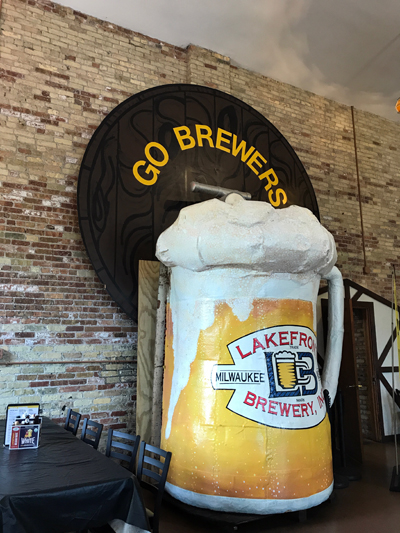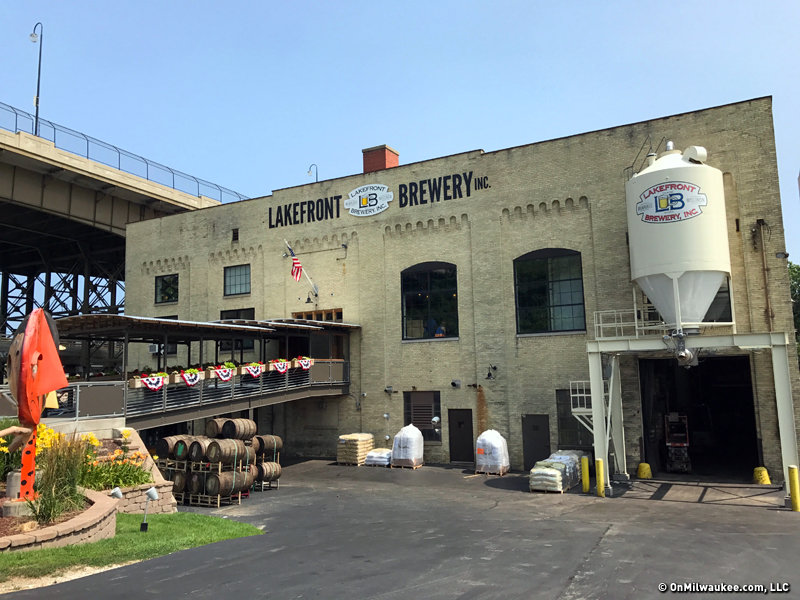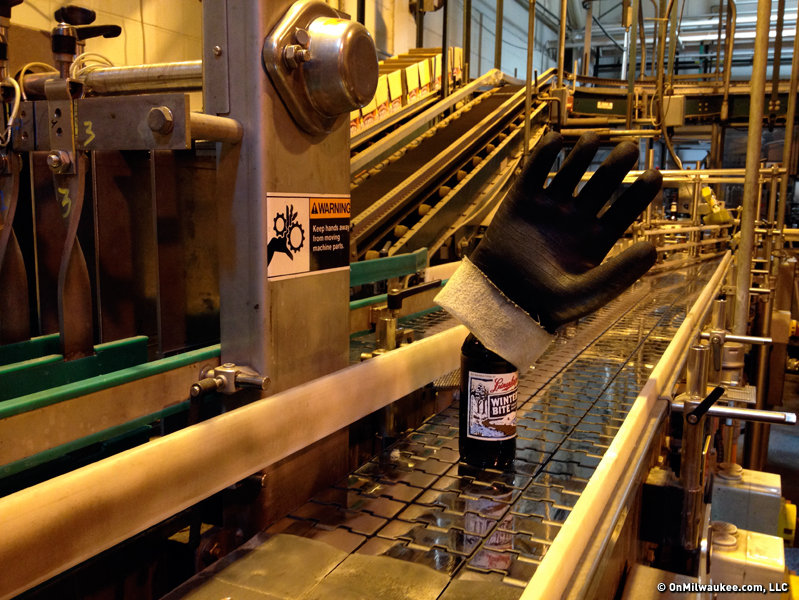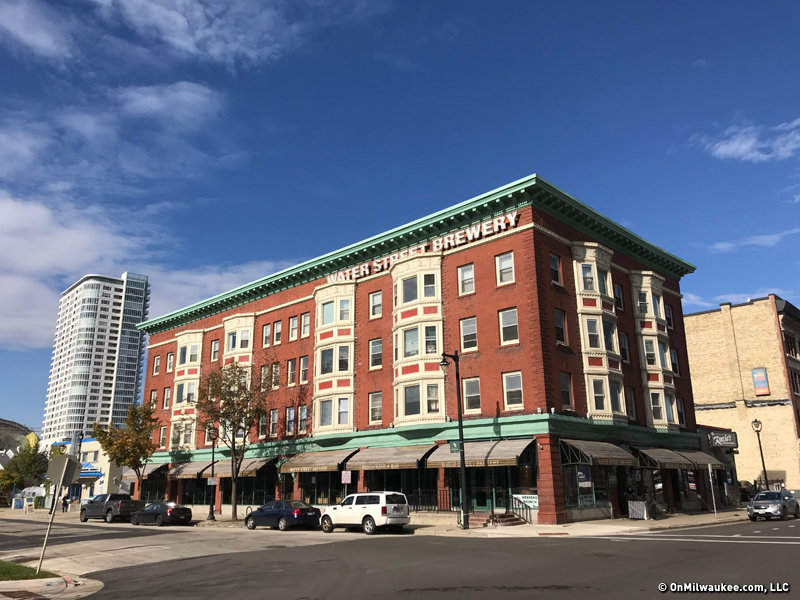If you moved to Milwaukee today, you might think Commerce Street has always been one long, snaking, full-of-life street, with apartments and condos, a brewery, a park perched on the side of the hill, a couple restaurants on and above it and more.
But when Lakefront Brewery, 1872 N. Commerce St., moved there in 1998, the street was anything but vigorous. There was a road. Not much in terms of sidewalks. A stretch of railtrack running along the base of the bluff. There was a lot of overgrown riverfront land. Some graffiti.

The same view, looking east, on Commerce Street, circa 1998 (above) and today (below).

"When we first moved here, I brewed third shift," remembers Jim Klisch, who founded the brewery with his brother Russ on Chambers Street in Riverwest in 1987. "And I'd have the garage door open and the brewing system is where it is right now. It was desolate.
"I remember I used to brew third shift on Chambers Street, and there was more traffic going through that alley during the night than there was here. I mean, it was totally desolate."

The same view, looking west, on Commerce Street, date unknown (above) and today (below).

So deserted was Commerce Street at the time that plans were floated to convert an old industrial building on the western end of the street into a prison.
The only thing missing was tumbleweeds.
But look at old photos of the stretch and you can see it once teemed with life. Commerce Street is the paved over remnant of the only stretch of Byron Kilbourn’s Milwaukee and Rock River Canal – begun in 1839 – that got built before the railroad boom quashed his big idea.


In the canal days, there were warehouses, wharves, ships docked along the river, horses and carriages. Even afterward, at the dying light of the 19th century and the dawn of the 20th, when the Lakefront Brewery building was a power plant generating electricity, old pictures show a Schlitz beer hall in a low building out in front, another two doors down.
That’s because people were here. Next door was Conrad Brothers’ tannery, and across the river was another huge tannery. Just up on Walnut (now Pleasant) was a hulking shoe factory. Nearby were a number of industrial buildings. Some of these places ran three shifts, meaning there were thirsty and hungry workers in the area 24 hours a day.
Spend a little time with Klisch, who oversees the brewery tours at Lakefront, and if you show an interest in history, he’ll tell you what he knows. He has a passion for the history of the brewery building and is eager to share.

The site as it appeared on Sanborn Fire Insurance Maps in 1894 (above) and 1910 (below).

It’s not exactly clear when the building was erected. The Wisconsin Historical Society suggests 1908, but Klisch has a pair of permits dated 1890 and 1908 for the site.
The earliest shows that architect Charles Kirchhoff had drawn plans for a three-story building, about 110x125 feet, which would seem to describe Lakefront’s home.
The latter permit is for a 108x117-foot building, but just a single story, and that seems to better describe a now-razed building out in front, at the sidewalk, that you can see in this photo below. Klisch says that it was a Schlitz beer hall, a fact confirmed by the sign you can see on the corner of the building.
Look at the 1894 map above and you'll notice that Schlitz owned property to the east, just on the other side of the old Holton Street Bridge.

So, sorry, Historical Society, I’m going with 1890.
The Milwaukee Light and Power Co. built the 1890 building as a power plant and inside were huge generators to create electricity. The six towering stacks that used to rise from the building suggest there were a half-dozen such generators.

Once, the building held generators. Now it holds brewing equipment.

The 1908 building, meanwhile, was built as a power plant by the Continental Realty Co., which may have either leased it or sold it to Schlitz, which reportedly also used it as a power plant.
One document in Klisch’s archive suggests that the entire property was sold to Schlitz in 1907 – though the permit listing Continental as owner in 1908 conflicts with that information – and that Schlitz sold to Ackley Land Co. in 1911, continuing to operate a tavern in the low building out front, at least briefly.
When Ackley sold to The Milwaukee Electric Railway and Light Co. in 1917, this document states, it was "with the condition that the Jos. Schlitz Brewing Company would be permitted to occupy the saloon building rent free until the brewing company would remove the building from the property within one year."
It appears that Continental Realty and Ackley Land were somehow related to Commonwealth Power, which operated the power plant during the years before the sale to TMER&L, which included not only this building but "all the franchises, permits, right and authorities, and all equipment, apparatus, meters, lamps, supplies, etc. under join or individual ownership or control of the Ackley Land Company, Continental Realty Company and Commonwealth Power Company."
In 1921, a portion of the site was sold to the city for the construction of the Holton Street Viaduct. In ‘42, part of the turbine room was leased to Allis Chalmers, and the following year, the company leased the entire plant until 1947.
In 1952, Wisconsin Electric Power Co. (the then-latest incarnation of TMER&L, and which is now We Energies) transformed the building into the headquarters for its underground electrical operations, an arrangement that lasted until 1976, when the building was sold.
The city’s forestry department then moved in and was the last tenant before Lakefront arrived.
In the late 1990s, Russ and Jim Klisch were brewing 3,000-4,000 barrels of beer up in Riverwest and selling to taverns that were close enough to roll barrels to. They wanted to grow and the city approached them about the former forestry headquarters.
"Department of City Development was searching someone to buy this," he says, "because the building would be slated to be torn down if they weren't able to sell it. I'd been familiar with this place for years. Back when it was a forestry department storage and headquarters. Their equipment was here. In the corner was a big mulch pile.

"I remember once – I used to be a Milwaukee cop – coming home, I was going over the viaduct and I smelled smoke. I came down here, and there was a mulch pile right underneath the Holton Street Bridge, before the marsupial bridge was constructed, and that was starting to burn. So they had a call box right over there, and I called it into the fire department. You know, there were gas pumps around here and everything."
Klisch says Russ knew right away the building was a perfect fit, but it wasn’t an easy deal to make.
"Our first finance company wouldn't support the loan for it," he says. "Because of the location. They called it a stinkhole. So we didn't know (the street's renaissance was coming). Nothing else was built here, but doing manufacturing you're pretty secure wherever you are."
But the deal was done and the brothers began to set up the brewery on Commerce Street, running the company out of two locations for a while.

"We were pretty small back then," Klisch recalls. "We had the Three Stooges tanks that you see out front now, and the bottling line. There wasn’t a lot of open space in the brewery – 3,600 square feet – that we vacated. That included the tours and everything – the whole thing."
For comparison's sake, the palm garden room alone on Commerce Street is twice the size of the entire original Lakefront Brewery.
Lakefront currently has about 50 full-time and 70 part-time employees.

But the sudden availability of space didn’t mean that Lakefront production was suddenly ratcheted up, Klisch says.
"The history of the brewery was slow and sure," he says. "You look at the new breweries that are starting up right now and they’ve got all the new equipment and the gleaming kettles and the tour room and the bright shiny buildings, here it's always been pay as you go. Slow, constant growth.
"There are ways we can increase production within the facility. We also own the property next door. We have to get our sales up to about 60,000 barrels before we'll float the loan. ... I'm going to shoot for 50,000 this year."

After Lakefront’s arrival, the neighborhood began to boom. Opposition to the prison plan had led to the creation of a Brewers Hill association and the cycle continued apace, returning life to the once moribund Commerce Street. Now, there’s almost no land left along the street to build upon.
Tours were the first big means for getting folks inside the brewery, according to Klisch.
"The city wanted it to be a people area," he says, "so we were obligated to start the tours ... they thought the tours would be a good kickoff for exposing people to the neighborhood."

Stop in on a sunny summer afternoon and Lakefront is bustling, even after the lunch crowd has returned to work. There are folks dining, families and couples sitting out at tables along the riverwalk, brewery tour groups and coming and going, and, of course, the brewery itself is humming along on the lower level, where it brews and ships nearly 50,000 31-gallon barrels’ worth of beer every year.
"It's hard to say (if the building boom helped business)," Klisch says. "We are a destination spot. I'm sure we get some people from the neighborhood that come for the tours, that come buy the beer. Certainly, improves the population that are aware that we're here and what we do."
Born in Brooklyn, N.Y., where he lived until he was 17, Bobby received his BA-Mass Communications from UWM in 1989 and has lived in Walker's Point, Bay View, Enderis Park, South Milwaukee and on the East Side.
He has published three non-fiction books in Italy – including one about an event in Milwaukee history, which was published in the U.S. in autumn 2010. Four more books, all about Milwaukee, have been published by The History Press.
With his most recent band, The Yell Leaders, Bobby released four LPs and had a songs featured in episodes of TV's "Party of Five" and "Dawson's Creek," and films in Japan, South America and the U.S. The Yell Leaders were named the best unsigned band in their region by VH-1 as part of its Rock Across America 1998 Tour. Most recently, the band contributed tracks to a UK vinyl/CD tribute to the Redskins and collaborated on a track with Italian novelist Enrico Remmert.
He's produced three installments of the "OMCD" series of local music compilations for OnMilwaukee.com and in 2007 produced a CD of Italian music and poetry.
In 2005, he was awarded the City of Asti's (Italy) Journalism Prize for his work focusing on that area. He has also won awards from the Milwaukee Press Club.
He has be heard on 88Nine Radio Milwaukee talking about his "Urban Spelunking" series of stories, in that station's most popular podcast.







